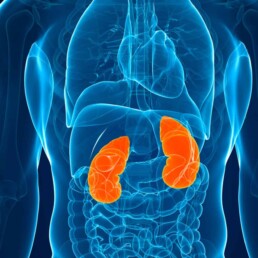Sodium, a vital mineral in our diet, plays a crucial role in maintaining fluid balance and supporting nerve and muscle function. However, striking the right balance in sodium intake is critical for both kidney and cardiovascular health. Recent studies have shown that both excessive and insufficient sodium intake can lead to adverse health outcomes, including cardiovascular mortality. This blog explores the dual role of sodium in blood pressure (BP) control and provides effective strategies for managing sodium intake to support overall health. It focuses on sodium intake in CKD.
By Majd Isreb, MD, FACP, FASN, IFMCP
The Double-Edged Sword of Sodium Intake
Understanding the Impact on Blood Pressure
The effect of sodium balance on blood pressure control is well-documented, making it a key dietary focus for those looking to maintain cardiovascular health. Excess sodium intake leads to a complex response in the body. However, the kidneys’ handling of sodium and changes in the blood vessels are the most crucial.
High sodium intake leads to twofold changes in the blood vessels, which increase their tonicity and raise blood pressure:
- It causes increased stiffness of the cells lining the blood vessels.
- It decreases the production of nitric oxide (NO), which dilates the blood vessels. Therefore, high sodium intake leads to blood vessel constriction by lowering the levels of NO.
The Renin-Angiotensin-Aldosterone System
Typically, elevated sodium intake decreases the kidneys’ production of a hormone called renin. Renin usually increases the production of angiotensin, which leads to vascular constriction. Angiotensin also stimulates the adrenal glands to produce a hormone called Aldosterone, which usually causes the kidneys to increase the excretion of sodium.
So, the decrease in angiotensin and aldosterone production helps the body get rid of the extra sodium and decrease blood pressure. This is called the renin-angiotensin-aldosterone system (RAAS). This system provides instantaneous feedback that helps the body regulate the sodium levels in the blood and blood pressure.
However, studies have shown that this system has limited capacity. So, at higher levels of sodium intake, aldosterone continues to be produced, which leads to sodium retention and increased blood pressure.
Sodium Intake and Health Outcomes
While high sodium intake has been found to increase blood volume and blood pressure. It was also found to decrease the normal dipping pattern of blood pressure during sleep. Elevated blood pressure is well known to increase cardiovascular events and mortality. Moderate restrictions of sodium were found to reverse all these effects.
However, excessive sodium restrictions were also found to increase the risk of cardiovascular events and death. This is believed to be due to the activation of the renin-angiotensin-aldosterone system and the increase in catecholamines (the fight-or-flight hormones).
This effect is summarized in this figure.
Sodium and Kidney Health
The kidneys play a pivotal role in sodium balance, filtering excess sodium into the urine. The renin-angiotensin-aldosterone system plays a major role in this process. In addition, the kidneys have an intricate system that helps them detect excessive sodium in the body and excrete sodium from various tubular segments. This process is crucial for body fluid maintenance and blood pressure regulation.
In chronic kidney disease (CKD), the body’s usual ability to handle increased sodium is weakened. This is because of the activation of the RAAS. Even though there is more sodium and fluid in the body, the activation of this system causes blood vessels to narrow and the body to hold onto sodium.
Other defense mechanisms, such as the production of NO, which helps blood vessels relax, are also weakened in CKD. This is why consuming a lot of sodium (more than 5 grams per day) can cause a significant increase in both blood volume and blood pressure.
Therefore, in CKD, high dietary sodium intake is associated with increased cardiovascular events and mortality. This is summarized in this figure.
Effects of High Sodium Intake in CKD
High sodium intake in CKD can lead to worse health outcomes. High sodium intake was found to increase the risk of progression in CKD. This is partly due to increasing blood pressure, which is known to increase the progression of CKD. However, high sodium intake was also found to increase sympathetic tone, oxidative stress, inflammation, vascular stiffness, and fibrosis in CKD. Higher sodium intake was also associated with an increase in proteinuria (protein in the urine).
On the other hand, excessive short-term restriction of sodium intake (less than 2 g/day) is found to decrease estimated GFR. It is not clear if this is associated with a long-term impact on kidney disease. Currently, the 2021 Kidney Disease: Improving Global Outcomes (KDIGO) clinical practice guidelines for the management of blood pressure in chronic kidney disease recommends that CKD patients with high blood pressure reduce their salt intake to less than 2 g/d of sodium.
Strategies for Balanced Sodium Intake in CKD
Assessing Your Sodium Needs
The first step in managing sodium intake is understanding your personal sodium needs, which can vary based on age, lifestyle, and health conditions. The general recommendation by health organizations is to limit sodium to less than 2,300 milligrams per day, roughly equivalent to a teaspoon of salt. However, for those with hypertension or kidney issues, even lower levels may be advisable. Consulting with a healthcare provider can help tailor these recommendations to individual needs.
Reading Food Labels Carefully
Packaged and processed foods contribute significantly to sodium intake. Learning to read food labels can be a game-changer in controlling sodium consumption. Look for terms like “low sodium,” “reduced sodium,” or “no salt added,” and be mindful of serving sizes as they relate to sodium content.
Incorporating Natural Sodium Sources
Instead of relying on added salts, incorporating natural sources of sodium can help manage intake levels. Foods like celery, beets, and carrots contain sodium naturally and provide additional nutrients beneficial for health.
Cooking and Seasoning Wisely
Home cooking is a powerful way to control sodium. Use herbs, spices, and salt-free seasoning blends to enhance flavor without adding extra sodium. Experimenting with lemon juice, vinegar, and various spice combinations can bring new life to dishes without compromising health. Salt substitutes can be used and were found to lower blood pressure. These substitutes contain potassium chloride and should be used with caution in patients with advanced CKD. Potassium citrate might be a better option.
The Bottom Line on Sodium Intake in CKD
Sodium intake requires careful consideration, especially for those concerned with kidney and cardiovascular health. By understanding the impacts of sodium, both high and low, and employing strategies to manage intake, individuals can protect their health while enjoying a flavorful diet. Remember, balance is key in maintaining optimal health outcomes related to sodium consumption.
This comprehensive approach to understanding and managing sodium intake in CKD highlights the importance of moderation and provides practical tips for maintaining kidney and cardiovascular health. Remember, individual needs can vary, so it’s important to consult with healthcare providers when making significant changes to your diet.










